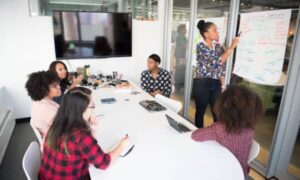Distractions in the office come in many forms. And they can be devastating to productivity, progress and your company’s bottom line. Given they are a multidirectional threat to business, it’s vital that you identify and handle office distractions early — or, ideally, before they even happen.
Perhaps the best way to measure the impact of distractions is by understanding the effect they have on your team’s productivity. Why is productivity important in business? What are the key reasons employees get distracted and how do they decrease productivity? And how can you handle office distractions?
Let’s take a look at answers to all these questions — and more — in this guide to productivity.
Distraction #1 – Smartphones
Smartphone technology is amongst the most significant contributors to distractions. Billions of people have smartphones and they are a source of endless alerts, notifications and temptations throughout the day.
How has technology affected productivity exactly? According to statistics, the average US individual spends at least four hours, 23 minutes on their smartphone daily. Research shows that workers waste eight hours weekly on average on their phones.
The four-plus hours we spend on our phones each day can easily spill over into work hours. After all, emails, calls, messages, and social media alerts don’t stop just because we’re in the office.
To escape the endless distractions of your phone, set it to ‘do not disturb’ or put it on airplane mode for blocks of time during the day. And only turn off these settings during designated break times in the work day.
To fight the temptation even more, consider putting your phone in another room or place it in your bag, drawer, or purse. Somewhere that is inconvenient to reach.
Distraction #2 – Background Noise
Another way to improve employee productivity is by creating a positive working environment by controlling background noise.
Pause for a second from your work and listen intently. One employee might be munching snacks loudly. Another might be listening to music. Still, another colleague might be running a machine or closing and opening the door loudly.
According to 2019 productivity statistics in the workplace, chatty workers were the main reason for workplace distractions. And 80% of respondents agreed noisy colleagues topped the factors that affect productivity in the workplace.
Since taking care of this noise is quite challenging, consider acquiring noise cancellation headphones. You can also go to a more serene place when you need to offer your work undivided attention. Try searching for an unused meeting room or dedicating a day at home to get meaningful work done.
Distraction #3 – Socializing
One of the factors that affect productivity in the workplace negatively, is overly socializing – by you, and by colleagues. Naturally, you want your workplace to be built on strong relationships and common bonds, but there are limits to stay within.
You may have close friends that like talking to you at work. Especially on a Monday after an exciting weekend. But, remember, you need to accomplish your work goals. This means socializing responsibly at a time and place that doesn’t distract your work, or those around you.
If your workplace has different offices, have your office door closed. Anyone coming in is likely to do so only when necessary. You can even include a ‘don’t disturb’ sign on the door to ensure you maximize your time usage at work.
If you work in an open office, you can incorporate measures like noise-blocking headphones or placing a sign on your desk when you are doing deep work. This way, only individuals with an urgent need for your input will approach you for help.
Also be considerate when dropping by someone else’s desk. Turning up unannounced can distract them and those around them.
Distraction #4 – A Disorganized Workplace
While a few pieces of paper here and there might not seem like a big deal, they can, if left unchecked, compound into a disorganized workplace.
A disorganized, chaotic workspace can often be a visual symbol of disorganization at deeper layers of your organization. And disorganization isn’t just in a physical sense. If your computer files, systems and tools are all over the place, too, it will significantly impact your team’s productivity by causing bottlenecks and inefficiencies.
There’s no expectation for military-level organization right down to freshly polished boots. Organize yourself so that only what you are tackling currently is before you. This will help keep your mind clear and focused on the most pressing tasks.
To keep your virtual presence organized, regularly review the tools and file organization of your team, culling any redundant aspects of your I.T. structure. Also create time to clean your work area, even if it’s only once a week.
Distraction #5 – Poor Health
Health goes beyond ensuring you aren’t sick. You should get adequate sleep to work effectively. That means that you should sleep at least seven hours to focus well on your tasks. Inadequate sleep makes you irritable, tired and less productive.
You also need to drink adequate water. Dehydrating yourself results in sluggishness and tiredness. When in this state, you are likely to lose focus on work, and resort to socializing or time wasting.
Don’t consistently skip meals to clear your workload, either. This can lead you to spend the rest of the afternoon thinking about your growling stomach instead of completing deep work. If you really can’t spare time for a proper lunch break, keep some healthy snacks at hand to keep you energized as you work.
Distraction #6 – Emails
Emails are an unavoidable part of work. But they can also be the enemy of deep, productive work if notifications are popping up every other minute.
The first thing to do is turn off email alerts and don’t keep your inbox open throughout the day. Instead, batch check your emails. Ideally once at the start of the day and once at the end of the day. Or, if need be, once in the middle of the day too.
It will likely be difficult to fight the urge to check your inboxes regularly during the day at first. But once batching your email becomes a habit, you will discover that very little is lost and a lot is gained in terms of productivity.
Final Words…
Distractions may be easy to understand but harder to spot and quantify. That’s where smart use of technology can come in.
Working with effective employee productivity software provides you with invaluable workplace insights and allows you to set productivity benchmarks. With this data, it’s easy to see employee productivity and trends which can point to distractions that may be causing low productivity.
It’s important to note that countering distractions is an ongoing task. And no workplace can expect to be 100 percent distraction free. Instead, your goal is to minimize distractions so your team can do their best work and feel engaged in the workplace.



































